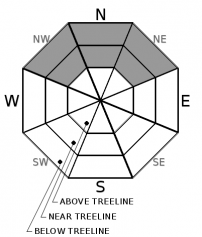| Monday | Monday Night | Tuesday | |
|---|---|---|---|
| Weather: | Partly cloudy then becoming mostly cloudy. Chance of thunderstorms and snow showers through the day. Snow levels below 7000 feet. Chance of precipitation is 50%. | Mostly cloudy then becoming partly cloudy. Chance of thunderstorms and snow showers through the night. Snow levels below 7000 feet. Chance of precipitation is 45%. | Mostly cloudy. Thunderstorms and snow showers likely. Snow levels below 7000 feet. Chance of precipitation is 60%. |
| Temperatures: | 34 to 40 deg. F. | 23 to 28 deg. F. | 30 to 36 deg. F. |
| Mid Slope Winds: | Light winds becoming southwest 15 to 25 mph with gusts to 45 mph in the afternoon. | Southwest 15 to 25 mph with gusts to 50 mph. | Southwest 15 to 25 mph with gusts to 45 mph. |
| Expected snowfall: | 80% probability of 1 to 3 inches. 20% probability of 2 to 4 inches. | SWE = up to 0.15 inch. | 90% probability of 1 to 4 inches. 10% probability of 1 to 2 inches. | SWE = up to 0.20 inch. | 90% probability of 1 to 4 inches. 10% probability of 1 to 2 inches. | SWE = up to 0.20 inch. |
| Monday | Monday Night | Tuesday | |
|---|---|---|---|
| Weather: | Partly cloudy then becoming mostly cloudy. Chance of thunderstorms and snow showers through the day. Snow levels below 7000 feet. Chance of precipitation is 50%. | Mostly cloudy then becoming partly cloudy. Chance of thunderstorms and snow showers through the night. Snow levels below 7000 feet. Chance of precipitation is 45%. | Mostly cloudy. Thunderstorms and snow showers likely. Snow levels below 7000 feet. Chance of precipitation is 60%. |
| Temperatures: | 29 to 35 deg. F. | 20 to 25 deg. F. | 25 to 31 deg. F. |
| Ridge Top Winds: | West around 15 mph increasing to southwest 25 to 35 mph in the afternoon. Gusts up to 60 mph. | Southwest 25 to 35 mph with gusts to 65 mph increasing to 30 to 50 mph with gusts to 95 mph after midnight. | Southwest 25 to 35 mph with gusts to 70 mph. |
| Expected snowfall: | 80% probability of 1 to 4 inches. 20% probability of 2 to 4 inches. | SWE = up to 0.15 inch. | 80% probability of 1 to 5 inches. 20% probability of 2 to 4 inches. | SWE = up to 0.30 inch. | 80% probability up to 4 inches. 20% probability of 2 to 4 inches. | SWE = up to 0.25 inch. |




















